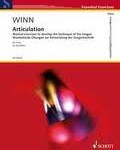 In many ways this is a book after my own heart. My years as an undergraduate with Bernard Goldberg were fraught with the re-working of my articulation. It would have been very useful to have such a book as this, with its written explanations (provided in English and German), numerous excerpts (some not found in other compilations), and standard as well as original studies.
In many ways this is a book after my own heart. My years as an undergraduate with Bernard Goldberg were fraught with the re-working of my articulation. It would have been very useful to have such a book as this, with its written explanations (provided in English and German), numerous excerpts (some not found in other compilations), and standard as well as original studies.
When one takes on the task of trying to describe the mechanics of articulation and relating it to one’s native language, there is a risk of getting bogged down in linguistic terminology. For the general flute-playing public I think this book walks the line very well between Too Much Information and the vague “finger-pointing-at-the -moon” sort of stuff you find elsewhere.
Once you do mention linguistics though, pedants like me crawl out of the woodwork with fingers and tongues wagging. There are several things I would like to wag on. Mind you, I am a pedant, not an expert, so my comments are below in the “Pedant’s Corner”.
It was very enlightening to read about some of Winn’s key concepts. He points out that some articulation difficulties are linked to the fingers in a way I hadn’t thought about, and going through some of the studies helped me sort that out. The position of the teeth, in front and in back, was something I had also not considered before.
All in all I enjoyed reading this book as well as playing the studies, although the text could have used a good editor for English punctuation and clarity. (I can’t comment on the German). I do hope that future editions will see to this.
Pedants Corner:
1. One basic aspect is ignored, that of aspiration in English and German consonants. If you are an English speaker, you will say the “T” in the name “Todd” differently from the “T” in “stick”. Todd’s “T” is aspirated. The tendency to puff air rather than release it from the mouth can pose a problem for beginning flute students of languages that do this.
2. In mentioning the tendencies for Russian and Bulgarian, Winn is correct that there is a large build-up of physical tension for the consonant “T”. One reason for that is it is produced with the tongue much further back than in English, touching the alveolar ridge. And it is never aspirated. However, that is only half of the picture. I don’t know about Bulgarian, but each Russian consonant is paired with its palatalized twin, a much softer version. A crude way of explaining this is to imagine the consonant followed by a “Y” (as in “you”) “TY” is very soft, produced very forward in the mouth and is more of a release than an attack. I spoke to someone who believes this linguistic ability is responsible for Denis Bouriakov’s amazing articulation.
Leave a Reply